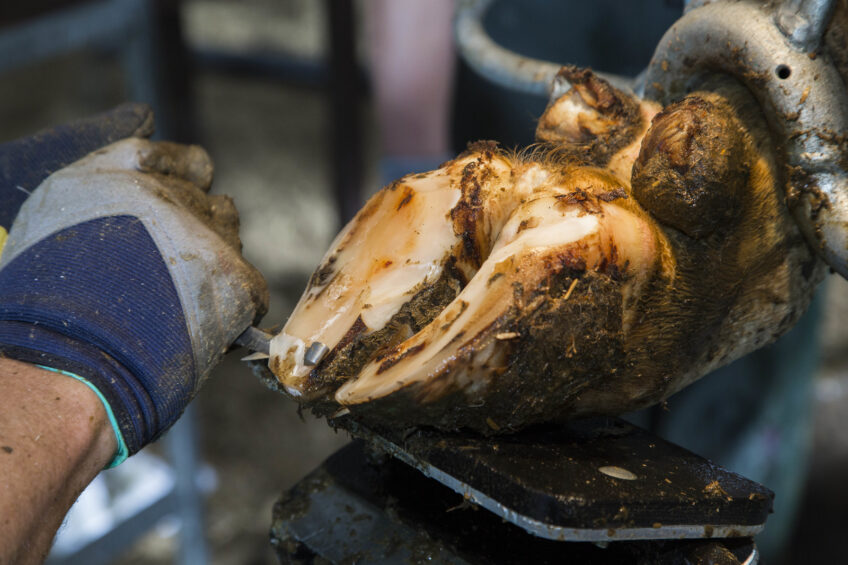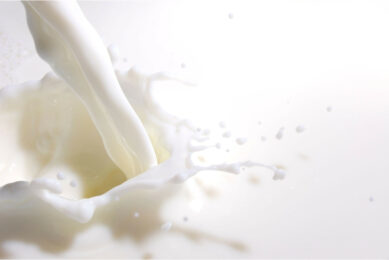Local treatment of claw lesions

Claw lesions like digital dermatitis are often treated with antibiotic sprays. However, this can penetrate the skin and leave residues in the milk. Non-antibiotic treatment is therefore recommended.
Veterinarians are often the ones that are allowed to use antibiotics in consumption animals, and the use of antibiotic products has to registered in detail.
However, in many countries it is still common practice that hoof trimmers and farmers buy antibiotics and apply them by themselves. In the past, it was assumed that locally and topically applied antibiotics are not able to pass the skin barrier when administered on the hoof. Thus, there would be no risk that antibiotic residues would end up in the milk by entering the bloodstream and exceed the Maximum Residue Limit (MRL) value.
Detection techniques have improved
A randomised clinical trial in 1999 investigated whether the topical treatment of claw lesions with oxytetracycline lead to residues in milk. This was determined with high-performance liquid chromatography (HPLC). No residues were detected at that time, but detection techniques have improved since. In 2015, a comparable study was performed using modern techniques. A total of 50 active DD lesions were treated with tetracycline bandage or tetracycline paste. Milk samples were analysed up to 168 hours after treatment using a commercially available immunotest (CHARM ROSA) and Liquid Chromatography – Mass Spectrometry (LC-MS). Of the 442 milk samples 105 were positive. Of the 45 samples taken at the first time point (after 8 hours), 5 were higher than the MRL value of 100 µg/kg. This recent study demonstrates that it is possible that local topically applied antibiotics on hoofs will eventually end up in the milk. Research on chickens confirms that antibiotics can end up at locations that you do not expect. The Dutch RIKILT Institute, for example, investigated feathers of chickens that received an antibiotic treatment with Enrofloxacine. The antibiogram of chicken feathers treated with antibiotics showed a clear zone of inhibition, indicating that the antibiotics accumulated in the feathers. This and other studies provide insight into how the exposure of animals to antibiotics leads to the presence of these compounds in tissues and other excreta of the animal (Figure 1). A recent survey of veterinarians and hoof trimmers by the American Association of Bovine Practitioners and the Hoof Trimmers Association conducted by Iowa State University also lead to one of the main conclusions that the topical use of (oxy)tetracyclines can lead to detectable residues in the milk. Also during administering of antibiotics in the hoof can also end up in other places on the leg. When these cows lie down immediately after treatment, this leg can infect the teats. In addition, it was also observed that workers touched the leg before the udder was prepared for milking. These were the animals that tested positive for tetracyclines in their milk.
Figure 1 – Schematic overview of the routes through which exposure of an animal to antibiotics eventually leads to the presence of these compounds in tissues and excreta of the animal.

Copper and zinc spray
Next to the undesired presence of antibiotics in consumer products such as milk, the overuse of antibiotics leads to the development of antimicrobial resistant pathogens. This will result in antibiotics that are becoming less and less effective, also in human medicine. Therefore it is important to search for non-antibiotic alternatives, such as a non-antibiotic aerosol spray*, based on copper and zinc, for which no MRL value is applicable and thus no withdrawal period. Copper is bactericidal and stimulates the formation of new blood vessels, which is an important phase in the wound healing process. Zinc supports the natural regenerative capacity of the skin and stimulates the growth of epithelial cells that form the top layer of the skin. The originally inorganic molecules Cu2+ and Zn2+ are covered (chelated) with an organic layer that provides unique properties. In a recent randomized clinical trial on 231 severe DD lesions in dairy cows on 7 different farms it has been demonstrated that Intra Repiderma has a cure rate of 86.8%, and is with half as many treatments 1.9x more effective than antibiotic spray.
* Intra Repiderma. References to research mentioned in the article are available on request.
Join 13,000+ subscribers
Subscribe to our newsletter to stay updated about all the need-to-know content in the dairy sector, two times a week.










